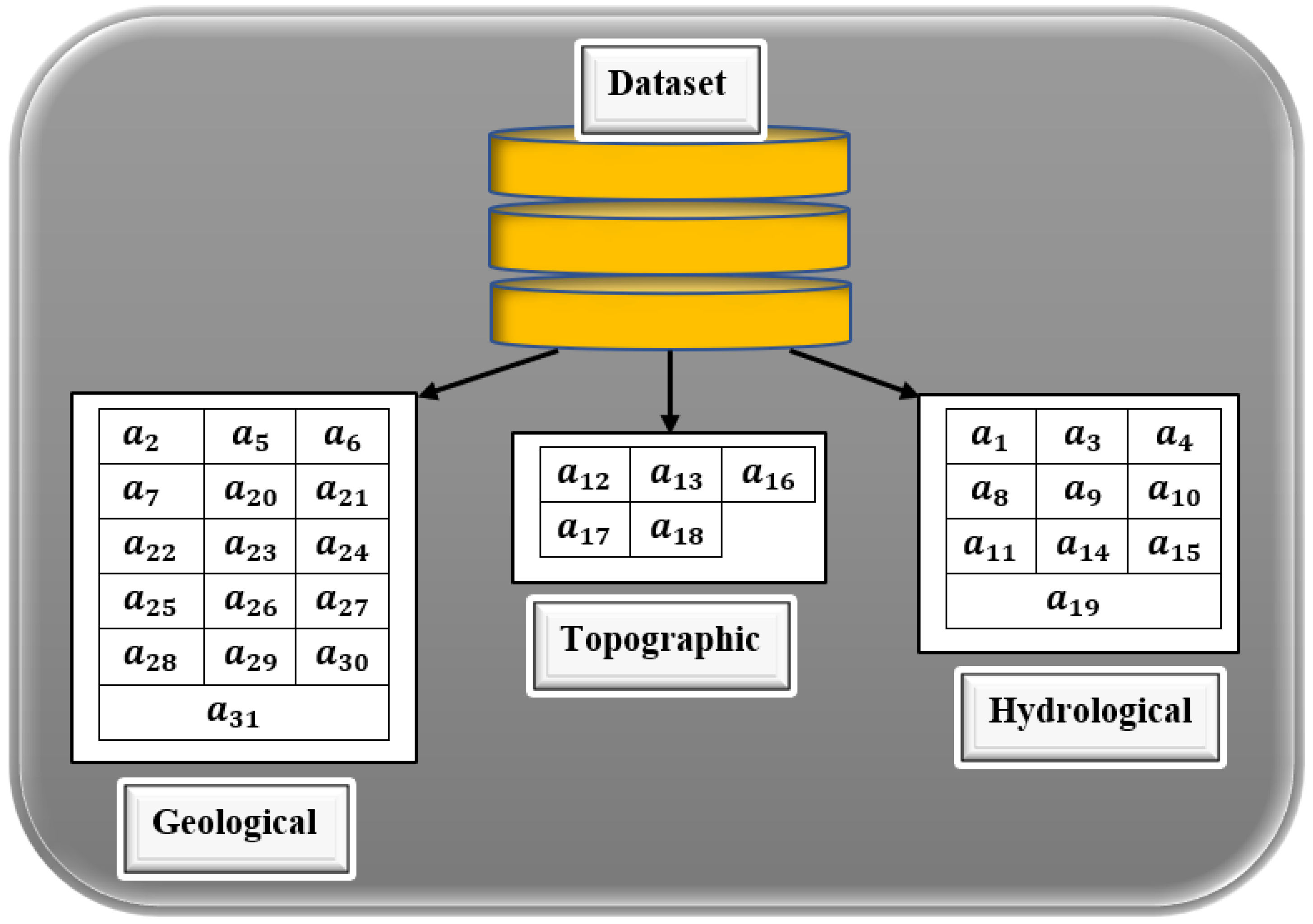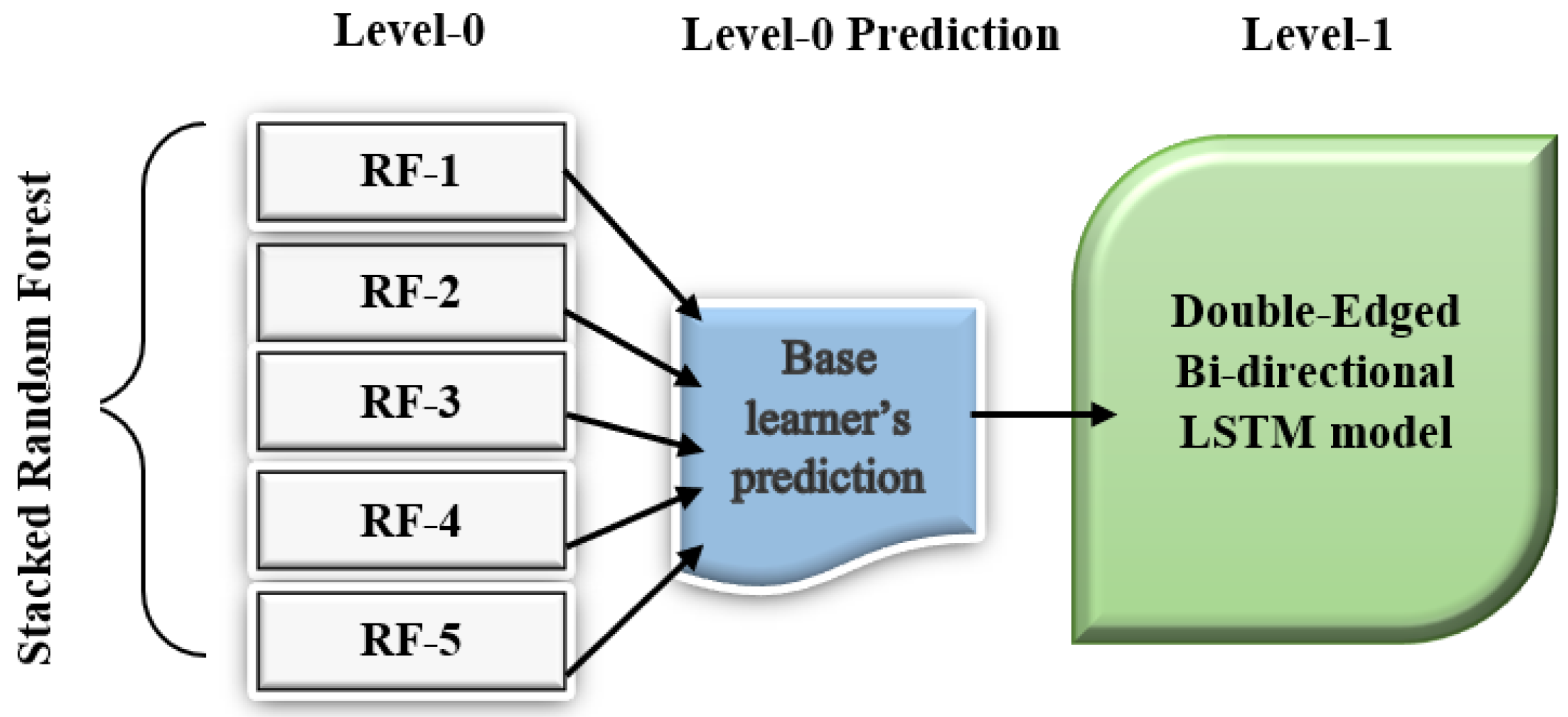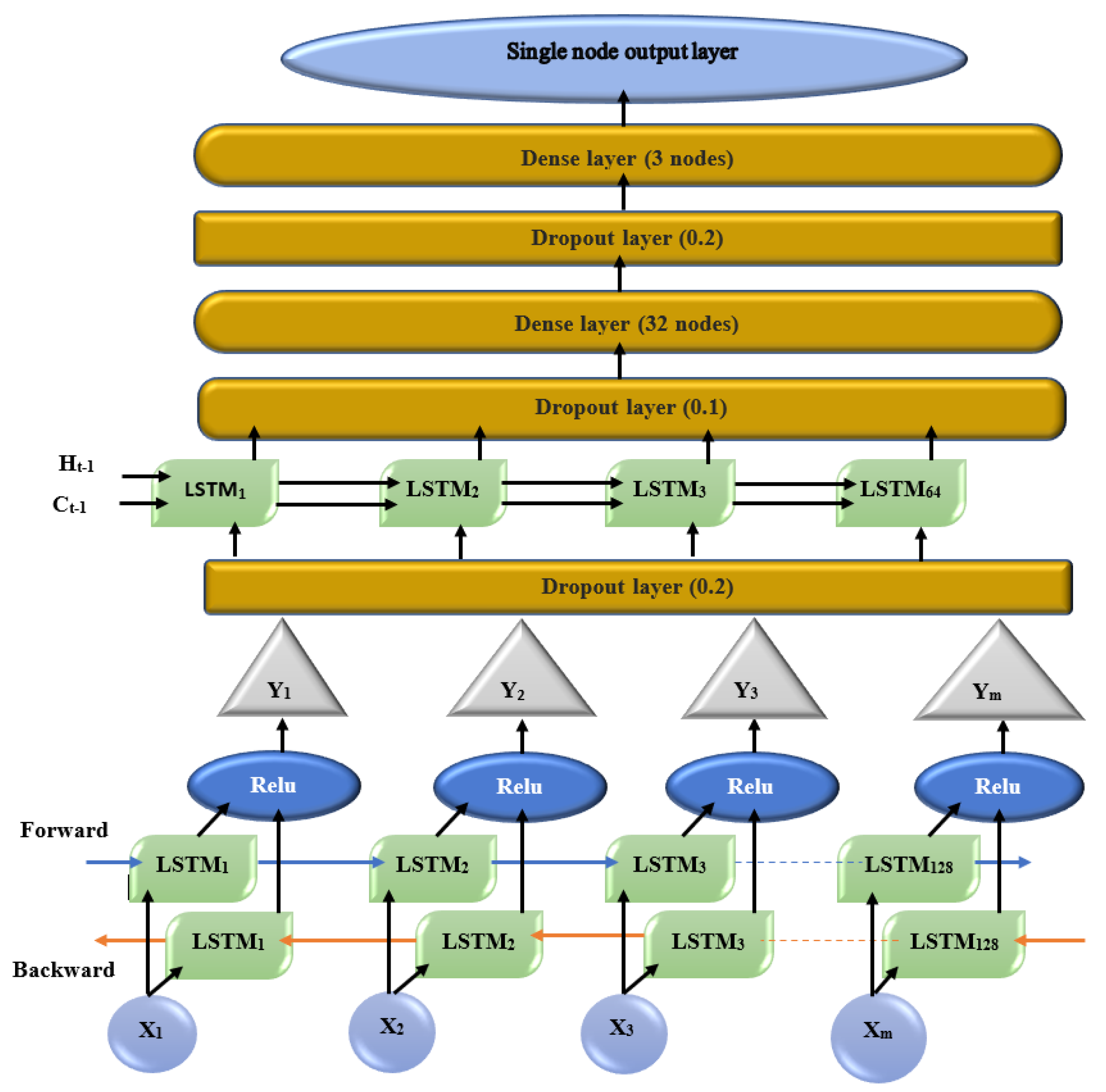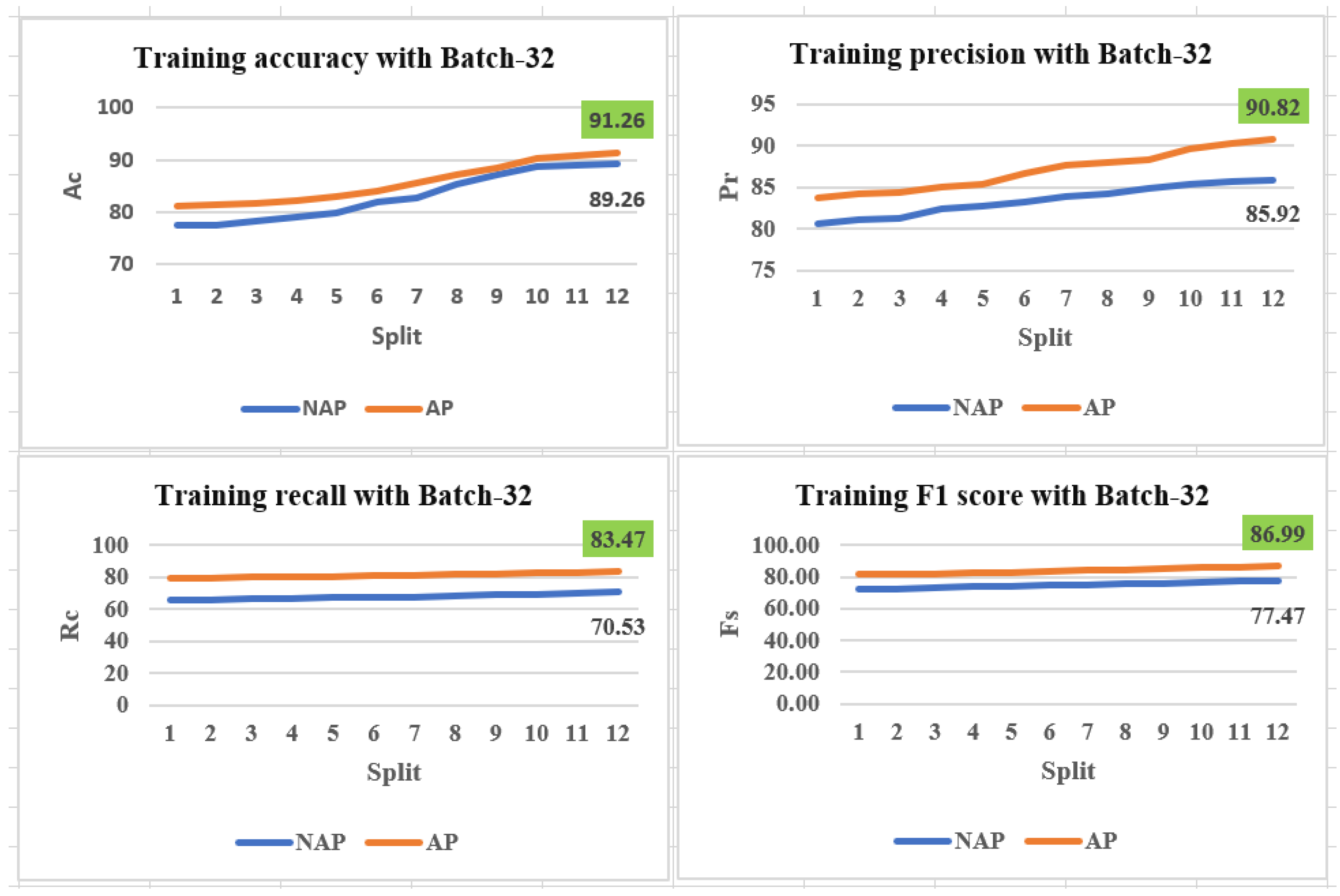Deep Ensemble-Based Approach Using Randomized Low-Rank Approximation for Sustainable Groundwater Level Prediction
Abstract
1. Introduction
1.1. Review on Groundwater Level Prediction Using Machine Learning Technique
1.2. Review on Groundwater Level Prediction Using a Deep Learning Technique
1.3. Review on Groundwater Level Prediction Using Ensemble Learning
- Machine learning methods struggle to handle enormous amounts of data in groundwater level prediction for huge geographical regions.
- Deep learning techniques have high computation time, and it is difficult to identify the better algorithm with hyperparameters upon feature selection in groundwater level prediction.
- Identifying the primary attributes for groundwater prediction is tedious, as every attribute has its own advantages and disadvantages that affect the generalization mechanism.
- Data pre-processing techniques used in the previous research led to information loss and, in turn, reduced the prediction accuracy.
- To obtain attributes using multi-collinearity by applying the variance inflation factor (VIF) value;
- To obtain the data approximation using the randomized low-rank approximation (RLRA) technique over the attribute selection;
- To combine random forest as a base learner using a stacking mechanism and double-edge bi-directional LSTM as a meta-classifier to obtain the deep ensemble Model (DEM);
- To find better classification accuracy, the DEM was applied to both approximated and non-approximated reduced datasets;
- To reduce the overfitting using the proposed DEM mechanism;
- To check for minimal or no information loss during data approximation to maintain data authenticity;
- To calculate the time taken to train and to test the data iteratively to assess the computation cost.
2. Background Fundamentals
2.1. Variance Inflation Factor (VIF)
| Algorithm 1 Feature selection using variance inflation factors |
Parameters:
Input: Input matrix is . Output: Reduced dataset is . Procedure to calculate the VIF value
|
2.2. Randomized Low-Rank Approximations
- (i)
- Singular Value Decomposition (SVD)
- (ii)
- Orthogonal Projections
- (iii)
- Norms
- (iv)
- Optimal Randomized Low-Rank Decomposition
| Algorithm 2 Approximation using RLRA. |
Parameters:
Input: Input matrix . Output: Reduced matrix . Procedure:
|
2.3. Ensemble Learning
2.3.1. Stacking Ensemble Learning
3. Proposed Research Methodology on Groundwater Level Prediction
3.1. Study Area Investigation and Data Pre-Processing
3.2. Feature Selection Using Multi Collinearity Test
3.3. Attribute Approximation Using Randomized Low-Rank Approximation Method
3.4. Proposed Deep Ensemble Model
3.4.1. Proposed Deep Ensemble Architecture
3.4.2. Double-Edged Bi-Directional LSTM
3.4.3. Proposed Training Process
| Algorithm 3 Ensemble model for groundwater level prediction |
Parameter:
|
4. Experimental Analysis According to Deep Ensemble Model
Performance Analysis Using Evaluation Metrics
5. Result and Discussion
6. Comparative Analysis with Existing Research Methods
7. Managerial Implications of the Proposed Groundwater Prediction Process
- Natural water rechargeability is average.
- Its utility for irrigation, industrial, and domestic purpose is high.
- Population growth is huge.
8. Conclusions and Future Work
Author Contributions
Funding
Institutional Review Board Statement
Informed Consent Statement
Data Availability Statement
Conflicts of Interest
Abbreviations
| UNICEF | United Nations Children’s Fund |
| NASA | National Aeronautics and Space Administration |
| GRACE | Gravity Recovery and Climate Experiment |
| GWL | Groundwater level |
| AI | Artificial intelligence |
| RF | Random forest |
| ML | Machine learning |
| ANN | Artificial neural network |
| RMSE | Root-mean-square error |
| SVR | Support-vector regression |
| ANFIS | Adaptive neuro-fuzzy inference system |
| DL | Deep learning |
| LSTM | Long short-term memory |
| SARIMA | Seasonal autoregressive integrated moving average |
| SVM | Support-vector machine |
| BRT | Boosted regression trees |
| CART | Classification and regression tree |
| GRU | Gated recurrent units |
| MLP | Multi-layer perceptron |
| RNN | Recurrent neural network |
| RLRA | Randomized low-rank approximation |
| VIF | Variance inflation factor |
| DEM | Deep ensemble model |
| DEBi-LSTM | Double-edge bi-directional LSTM |
References
- Water Scarcity. Available online: https://www.unicef.org/wash/water-scarcity (accessed on 20 May 2022).
- Space Applications Centre, ISRO. Desertification and Land Degradation Atlas of Selected Districts of India (Based on IRS LISS III data of 2011–13 and 2003–05); Space Applications Centre (ISRO): Ahmedabad, India, 2016; pp. 1–219. [Google Scholar]
- Chindarkar, N.; Grafton, R.Q. India’s depleting groundwater: When science meets policy. Asia Pac. Policy Stud. 2019, 6, 108–124. [Google Scholar] [CrossRef]
- Rodell, M.; Houser, P.R.; Jambor, U.; Gottschalck, J.; Mitchell, K.; Meng, C.-J.; Arsenault, K.; Cosgrove, B.; Radakovich, J.; Bosilovich, M.; et al. The Global Land Data Assimilation System. Bull. Am. Meteorol. Soc. 2004, 85, 381–394. [Google Scholar] [CrossRef]
- India State Map, List of States in India. Available online: https://www.whereig.com/india/states/ (accessed on 20 May 2022).
- Knoll, L.; Breuer, L.; Bach, M. Large scale prediction of groundwater nitrate concentrations from spatial data using machine learning. Sci. Total Environ. 2019, 668, 1317–1327. [Google Scholar] [CrossRef] [PubMed]
- Majumdar, S.; Smith, R.; Butler, J.J., Jr.; Lakshmi, V. Groundwater withdrawal prediction using integrated multitemporal remote sensing data sets and machine learning. Water Resour. Res. 2020, 56, e2020WR028059. [Google Scholar] [CrossRef]
- Adiat, K.A.N.; Ajayi, O.F.; Akinlalu, A.A.; Tijani, I.B. Prediction of groundwater level in basement complex terrain using artificial neural network: A case of Ijebu-Jesa, southwestern Nigeria. Appl. Water Sci. 2020, 10, 1–14. [Google Scholar] [CrossRef]
- Hussein, E.A.; Thron, C.; Ghaziasgar, M.; Bagula, A.; Vaccari, M. Groundwater prediction using machine-learning tools. Algorithms 2020, 13, 300. [Google Scholar] [CrossRef]
- Banadkooki, F.B.; Ehteram, M.; Ahmed, A.N.; Teo, F.Y.; Fia, C.M.; Afan, H.A.; Sapitang, M.; Shafie, A.E. Enhancement of Groundwater-Level Prediction Using an Integrated Machine Learning Model Optimized by Whale Algorithm. Nat. Resour. Res. 2020, 29, 3233–3252. [Google Scholar] [CrossRef]
- Huang, X.; Gao, L.; Crosbie, R.S.; Zhang, N.; Fu, G.; Doble, R. Groundwater recharge prediction using linear regression, multi-layer perception network, and deep learning. Water 2019, 11, 1879. [Google Scholar] [CrossRef]
- Chen, Y.; Chen, W.; Chandra Pal, S.; Saha, A.; Chowdhuri, I.; Adeli, B.; Janizadeh, S.; Dineva, A.A.; Wang, X.; Mosavi, A. Evaluation efficiency of hybrid deep learning algorithms with neural network decision tree and boosting methods for predicting groundwater potential. Geocarto Int. 2021, 37, 1–21. [Google Scholar] [CrossRef]
- Kochhar, A.; Singh, H.; Sahoo, S.; Litoria, P.K.; Pateriya, B. Prediction and forecast of pre-monsoon and post-monsoon groundwater level: Using deep learning and statistical modelling. Model. Earth Syst. Environ. 2022, 8, 2317–2329. [Google Scholar] [CrossRef]
- Sun, J.; Hu, L.; Li, D.; Sun, K.; Yang, Z. Data-driven models for accurate groundwater level prediction and their practical significance in groundwater management. J. Hydrol. 2022, 608, 127630. [Google Scholar] [CrossRef]
- Oyedele, A.A.; Ajayi, A.O.; Oyedelec, L.O.; Bello, S.A.; Jimoh, K.O. Performance evaluation of deep learning and boosted trees for cryptocurrency closing price prediction. Expert Syst. Appl. 2022, 213, 119233. [Google Scholar] [CrossRef]
- Jiménez-Mesa, C.; Ramírez, J.; Suckling, J.; Vöglein, J.; Levin, J.; Górriz, J.M.; DIAN, D.I.A.N. Deep Learning in current Neuroimaging: A multivariate approach with power and type I error control but arguable generalization ability. arXiv 2021, arXiv:2103.16685. [Google Scholar] [CrossRef]
- Mosavi, A.; Hosseini, F.S.; Choubin, B.; Abdolshahnejad, M.; Gharechaee, H.; Lahijanzadeh, A.; Dineva, A.A. Sustainability prediction of groundwater hardness using ensemble machine learning models. Water 2008, 12, 2770. [Google Scholar] [CrossRef]
- Yin, J.; Medellín-Azuara, J.; Escriva-Bou, A.; Liu, Z. Bayesian machine learning ensemble approach to quantify model uncertainty in predicting groundwater storage change. Sci. Total Environ. 2021, 769, 144715. [Google Scholar] [CrossRef]
- Jiang, F.; Yu, X.; Du, J.; Gong, D.; Zhang, Y.; Peng, Y. Ensemble learning based on approximate reducts and bootstrap sampling. Inf. Sci. 2021, 547, 797–813. [Google Scholar] [CrossRef]
- Mosavi, A.; Hosseini, F.S.; Choubin, B.; Goodarzi, M.; Dineva, A.A.; Rafiei Sardooi, E. Ensemble boosting and bagging based machine learning models for groundwater potential prediction. Water Resour. Manag. 2021, 35, 23–37. [Google Scholar] [CrossRef]
- Lee, J.; Hong, H.; Song, J.M.; Yeom, E. Neural network ensemble model for prediction of erythrocyte sedimentation rate (ESR) using partial least squares regression. Sci. Rep. 2022, 12, 1–13. [Google Scholar] [CrossRef]
- Li, Y.; Pan, Y. A novel ensemble deep learning model for stock prediction based on stock prices and news. Int. J. Data Sci. Anal. 2022, 13, 139–149. [Google Scholar] [CrossRef]
- Ngo, N.T.; Pham, A.D.; Truong, T.T.H.; Truong, N.S.; Huynh, N.T.; Pham, T.M. An ensemble machine learning model for enhancing the prediction accuracy of energy consumption in buildings. Arab. J. Sci. Eng. 2022, 47, 4105–4117. [Google Scholar] [CrossRef]
- Kumar, N.K.; Schneider, J. Literature survey on low rank approximation of matrices. Linear Multilinear Algebra 2017, 65, 2212–2244. [Google Scholar] [CrossRef]
- Sapp, B.J. Randomized Algorithms for Low-Rank Matrix Decomposition; Computer and Information Science, University of Pennsylvania: Philadelphia, PA, USA, 2011; pp. 1–43. [Google Scholar]
- Eckart, C.; Young, G. The approximation of one matrix by another of lower rank. Psychometrika 1936, 1, 211–218. [Google Scholar] [CrossRef]
- Halko, N.; Martinsson, P.G.; Tropp, J.A. Finding structure with randomness: Probabilistic algorithms for constructing approximate matrix decompositions. SIAM Rev. 2011, 53, 217–288. [Google Scholar] [CrossRef]
- Mohammed, A.; Kora, R. An effective ensemble deep learning framework for text classification. J. King Saud-Univ. Inf. Sci. 2022, 34, 8825–8837. [Google Scholar] [CrossRef]
- Chen, W.; Lei, X.; Chakrabortty, R.; Pal, S.C.; Sahana, M.; Janizadeh, S. Evaluation of different boosting ensemble machine learning models and novel deep learning and boosting framework for head-cut gully erosion susceptibility. J. Environ. Manag. 2021, 284, 112015. [Google Scholar] [CrossRef] [PubMed]
- Konstantinov, A.V.; Utkin, L.V. Interpretable machine learning with an ensemble of gradient boosting machines. Knowl.-Based Syst. 2021, 222, 106993. [Google Scholar] [CrossRef]
- Ma, M.; Liu, C.; Wei, R.; Liang, B.; Dai, J. Predicting machine’s performance record using the stacked long short-term memory (LSTM) neural networks. J. Appl. Clin. Med. Phys. 2022, 23, e13558. [Google Scholar] [CrossRef]
- Ground Water Data Access. Available online: http://cgwb.gov.in/GW-data-access.html (accessed on 20 May 2022).
- Hochreiter, S.; Schmidhuber, J. Long short-term memory. Neural Comput. 1997, 9, 1735–1780. [Google Scholar] [CrossRef]
- Hochreiter, S. Untersuchungen zu Dynamischen Neuronalen Netzen. Diploma Thesis, TU Munich, Munich, Germany, 1991. [Google Scholar]
- Park, C.; Chung, I.M. Evaluating the groundwater prediction using LSTM model. J. Korea Water Resour. Assoc. 2020, 53, 273–283. [Google Scholar] [CrossRef]
- India Groundwater: A Valuable but Diminishing Resource. Available online: https://www.worldbank.org/en/news/feature/2012/03/06/india-groundwater-critical-diminishing (accessed on 20 May 2022).
- India Water Resources Information System. Available online: https://indiawris.gov.in/wris/#/groundWater (accessed on 20 May 2022).


















| Cl () (ppm) | Mg () (ppm) | Mn () (ppm) | Fe () (ppm) | Ca () (ppm) | Zn () (ppm) | Cu () (ppm) |
|---|---|---|---|---|---|---|
| 0.22 | 31.33 | 5.3 | 19.98 | 38.2 | 2.67 | 2 |
| 0.67 | 42.44 | 4.7 | 6.01 | 35.8 | 4.97 | 3 |
| 0.22 | 43.13 | 9.4 | 8.89 | 17 | 3.11 | 2 |
| 0.35 | 22.45 | 9.5 | 12.25 | 11.3 | 6.34 | 1 |
| 0.7 | 52.87 | 9.8 | 3.2 | 32.5 | 4.81 | 4 |
| 0.13 | 43.36 | 0.9 | 17.1 | 26.2 | 7.32 | 4 |
| 0.8 | 29.19 | 9.2 | 8.5 | 27.1 | 2.64 | 3 |
| 0.44 | 34.56 | 2.7 | 6.62 | 15.6 | 1.37 | 2 |
| 0.1 | 37.23 | 4.4 | 16.21 | 15.3 | 2.22 | 1 |
| 0.9 | 41.78 | 4.1 | 1.98 | 11.02 | 3.71 | 2 |
| Summary | Attribute | ||||||
|---|---|---|---|---|---|---|---|
| Multiple R | 0.927 | 0.681 | 0.425 | 0.433 | 0.819 | 0.399 | 0.895 |
| R Square | 0.860 | 0.464 | 0.181 | 0.187 | 0.671 | 0.159 | 0.802 |
| Adjusted R Square | 0.438 | −0.429 | −0.638 | −0.300 | 0.561 | 0.039 | 0.207 |
| Standard Error | 0.224 | 10.686 | 4.369 | 6.059 | 6.135 | 1.926 | 1.006 |
| VIF value | 7.120 | 1.866 | 1.221 | 1.231 | 3.037 | 1.190 | 5.047 |
| 31.33 | 5.3 | 19.98 | 38.2 | 2.67 |
| 42.44 | 4.7 | 6.01 | 35.8 | 4.97 |
| 43.13 | 9.4 | 8.89 | 17 | 3.11 |
| 22.45 | 9.5 | 12.25 | 11.3 | 6.34 |
| 52.87 | 9.8 | 3.2 | 32.5 | 4.81 |
| 43.36 | 0.9 | 17.1 | 26.2 | 7.32 |
| 29.19 | 9.2 | 8.5 | 27.1 | 2.64 |
| 34.56 | 2.7 | 6.62 | 15.6 | 1.37 |
| 37.23 | 4.4 | 16.21 | 15.3 | 2.22 |
| 41.78 | 4.1 | 1.98 | 11.02 | 3.71 |
| 31.48 | 5.61 | 20.55 | 37.19 | 3.12 |
| 43.15 | 5.48 | 6.42 | 36.05 | 4.55 |
| 42.70 | 10.39 | 8.49 | 15.62 | 3.57 |
| 23.11 | 10.97 | 12.04 | 13.25 | 5.86 |
| 54.37 | 10.02 | 3.28 | 31.38 | 4.62 |
| 42.65 | 1.32 | 16.96 | 28.22 | 7.70 |
| 30.28 | 9.55 | 8.82 | 25.56 | 3.57 |
| 33.14 | 2.55 | 6.39 | 18.89 | 1.95 |
| 39.07 | 4.60 | 15.78 | 16.38 | 3.17 |
| 43.00 | 4.71 | 1.46 | 10.31 | 2.68 |
| Contingency Factors | Attribute Names | Notation | Possible Range | Max Value |
|---|---|---|---|---|
| Geological | Depth of water | (0–4.21) | 4.21 | |
| extractable GW resource | (0.005–66.88) | 66.88 | ||
| Total GW extraction | (0.005–46.03) | 46.03 | ||
| GW availability | (0.002–21.53) | 21.53 | ||
| Aquatic veg land | (0–228,174) | 228,174 | ||
| Cultivable land | (1.5–25,503.7) | 25,503.7 | ||
| Nitrogen | (1–2.98) | 2.98 | ||
| Phosphorus | (1.02–2.54) | 2.54 | ||
| Potassium | (1.03–2.69) | 2.69 | ||
| Organic carbon | (1.12–2.99) | 2.99 | ||
| Boron | (1–2) | 2 | ||
| Copper | (1.38–2) | 2 | ||
| Iron | (1.34–2) | 2 | ||
| Manganese | (1.28–2) | 2 | ||
| Sulpher | (1–2) | 2 | ||
| Zinc | (1.38–1.99) | 1.99 | ||
| GWL decision | (1–3) | 3 | ||
| Topographic | Land degradation | (42–18,034,066) | 18,034,066 | |
| Wasteland | (81.27–175,697) | 175,697 | ||
| Geo area | (3000–34,223,900) | 34,223,900 | ||
| Forest ecosystem | (2591–84,147) | 84,147 | ||
| Wetland | (350–3,474,950) | 3,474,950 | ||
| Hydrological | Rainfall | (351.8–4489.5) | 4489.5 | |
| GW recharge | (0.01–72.2) | 72.2 | ||
| Natural GW discharge | (0.001–5.32) | 5.32 | ||
| GW temperature | (0–39) | 39 | ||
| GW dissolved O2 | (0–9.1) | 9.1 | ||
| GW pH | (0–9.7) | 9.7 | ||
| GW nitrate | (0–50) | 50 | ||
| Soil depth | (25–50) | 50 | ||
| soil pH | (5–8.4) | 8.4 | ||
| Open water | (242–1,150,755) | 1,150,755 |
| Attribute | VIF | Attribute | VIF | Attribute | VIF | Attribute | VIF |
|---|---|---|---|---|---|---|---|
| 1.2 | 2.99 | 3 | 1.01 | ||||
| 3.8 | 2.48 | 10.2 | 1.63 | ||||
| 1.6 | 1.34 | 9.25 | 7.89 | ||||
| 1.04 | 9.7 | 2.25 | 4.75 | ||||
| 8.27 | 1 | 2.46 | 4.35 | ||||
| 7.78 | 2.22 | 3.59 | 8.66 | ||||
| 5.07 | 1.79 | 3.55 | 3.32 | ||||
| 1.35 | 9.93 | 5.12 | 1.2 |
| Hyper-Parameters | Choice Option | Best Choice |
|---|---|---|
| Batch size | (64, 32, 20) | 32 |
| Number of epochs | (2, 4, 6, 8) | 2 |
| Number of memory units | (256, 128) (128, 64) (64, 32) (32, 10) | (128, 64) |
| Number of dropouts | (0.2, 0.1) | 0.1 |
| Learning rate | 0.01 | 0.01 |
| Optimizer | ADAM, RmsProp | ADAM |
| Split | Approximated Dataset | Non-Approximated Dataset | ||||
|---|---|---|---|---|---|---|
| Batch-64 | Batch-32 | Batch-20 | Batch-64 | Batch-32 | Batch-20 | |
| 1 | 78.51 | 81.07 | 72.33 | 74.17 | 77.42 | 70.12 |
| 2 | 79 | 81.36 | 73.87 | 74.78 | 77.57 | 70.46 |
| 3 | 79.76 | 81.69 | 75.29 | 75.51 | 78.21 | 70.93 |
| 4 | 80.42 | 82.11 | 76.81 | 77.03 | 79.15 | 71.47 |
| 5 | 81.19 | 82.9 | 78.24 | 78.68 | 79.82 | 72.22 |
| 6 | 83.24 | 84.18 | 79.47 | 80.74 | 81.93 | 74.38 |
| 7 | 84.49 | 85.73 | 80.32 | 82.37 | 82.76 | 75 |
| 8 | 84.93 | 87.1 | 80.7 | 82.9 | 85.37 | 76.4 |
| 9 | 85.57 | 88.56 | 82.66 | 84.14 | 87.14 | 78.61 |
| 10 | 86.14 | 90.2 | 84.1 | 84.39 | 88.63 | 80.14 |
| 11 | 86.92 | 90.78 | 84.86 | 85.55 | 89.02 | 82.44 |
| 12 | 87.34 | 91.26 | 85.13 | 85.82 | 89.26 | 83.03 |
| Batch Size | Iteration | Accuracy | Precision | Recall | -Score | |||||
|---|---|---|---|---|---|---|---|---|---|---|
| NAP | AP | NAP | AP | NAP | AP | NAP | AP | NAP | AP | |
| 64 | 210 | 160 | 69.2 | 76.9 | 33.33 | 43.75 | 44.4 | 5 | 34.37 | 46.43 |
| 32 | 190 | 130 | 89.26 | 91.26 | 82.49 | 91.67 | 62.5 | 97.22 | 71.12 | 94.36 |
| 20 | 250 | 140 | 78.4 | 84.6 | 56.25 | 83.33 | 59.72 | 84.72 | 50.2 | 77.7 |
| Split | Approximated Dataset | Non-Approximated Dataset | ||||
|---|---|---|---|---|---|---|
| Batch-64 | Batch-32 | Batch-20 | Batch-64 | Batch-32 | Batch-20 | |
| 1 | 84.77 | 89.14 | 78.96 | 80.47 | 86.31 | 77.26 |
| 2 | 85.37 | 89.64 | 79.25 | 80.72 | 87.53 | 78.1 |
| 3 | 86.48 | 90.27 | 80.76 | 82.25 | 89.03 | 78.59 |
| 4 | 87.13 | 92.96 | 83.31 | 83.39 | 89.86 | 80.73 |
| 5 | 87.79 | 93.57 | 84.7 | 84.67 | 90.7 | 82.91 |
| 6 | 88.18 | 94.81 | 86.24 | 85.11 | 91.48 | 83.63 |
| 7 | 89.57 | 95.73 | 86.59 | 86.52 | 92.89 | 84.47 |
| 8 | 90.28 | 96.1 | 87.66 | 87.41 | 93.76 | 85.3 |
| Split | Proposed DEM | LSTM [35] | Bagging RF [20] | Ensemble Model [18] | ||||||||||||
|---|---|---|---|---|---|---|---|---|---|---|---|---|---|---|---|---|
| Ac | Pr | Rc | Fs | Ac | Pr | Rc | Fs | Ac | Pr | Rc | Fs | Ac | Pr | Rc | Fs | |
| 1 | 89.14 | 87.76 | 80.23 | 83.83 | 78.1 | 79.91 | 39.6 | 52.96 | 77.10 | 82.33 | 44.61 | 57.87 | 75.3 | 80.47 | 37.18 | 50.86 |
| 2 | 89.64 | 88.36 | 80.71 | 84.36 | 77.5 | 81.47 | 43.32 | 56.56 | 78.60 | 82.71 | 42.13 | 55.82 | 76.6 | 81.13 | 37.29 | 51.10 |
| 3 | 90.27 | 88.9 | 81.4 | 84.98 | 80 | 81.87 | 41.92 | 55.45 | 81.60 | 83.11 | 43.47 | 57.08 | 79 | 81.36 | 40.83 | 54.37 |
| 4 | 92.96 | 90.32 | 82.17 | 86.05 | 80.9 | 82.27 | 47.66 | 60.36 | 85.80 | 83.43 | 53.32 | 65.06 | 79.7 | 81.78 | 46.51 | 59.30 |
| 5 | 93.57 | 91.75 | 83.52 | 87.44 | 83.4 | 82.45 | 48.96 | 61.44 | 88.80 | 83.97 | 60.44 | 70.29 | 83.9 | 82.25 | 45.77 | 58.81 |
| 6 | 94.81 | 92.5 | 84.04 | 88.07 | 84.4 | 82.78 | 54.88 | 66.00 | 89.70 | 84.57 | 60.72 | 70.69 | 84.7 | 82.6 | 54.31 | 65.53 |
| 7 | 95.73 | 93.47 | 84.67 | 88.85 | 86.4 | 83.05 | 54.8 | 66.03 | 90.40 | 85.69 | 66.34 | 74.78 | 85.5 | 82.83 | 57.31 | 67.75 |
| 8 | 96.1 | 93.87 | 85.14 | 89.29 | 89.5 | 83.12 | 56.54 | 67.30 | 90.60 | 85.82 | 70 | 77.11 | 87.9 | 84 | 55.48 | 66.82 |
| States | 2015 | 2016 | 2017 | 2018 | 2019 | 2020 | 2021 | 2022 |
|---|---|---|---|---|---|---|---|---|
| UP | 154.45 | 205.43 | 216.29 | 211.98 | 383.38 | 188.40 | 251.54 | 135.17 |
| UK | 309.84 | 350.36 | 394.64 | 396.79 | 383.38 | 330.17 | 434.58 | 361.81 |
| HR | 123.77 | 102.13 | 117.62 | 129.82 | 100.00 | 120.03 | 170.22 | 158.17 |
| CH | 123.77 | 102.13 | 117.62 | 129.82 | 100.00 | 120.03 | 170.22 | 158.17 |
| DL | 171.09 | 126.36 | 128.12 | 135.99 | 124.86 | 121.37 | 243.08 | 131.62 |
| PB | 154.21 | 123.82 | 142.59 | 172.58 | 177.15 | 140.67 | 157.32 | 176.68 |
| HP | 315.99 | 250.79 | 310.89 | 294.30 | 302.41 | 230.62 | 244.42 | 290.55 |
| RJ | 134.29 | 141.63 | 120.68 | 102.63 | 163.60 | 109.21 | 141.57 | 161.17 |
| MP | 249.84 | 296.68 | 199.21 | 221.62 | 352.47 | 253.78 | 257.26 | 282.52 |
| GJ | 155.71 | 157.75 | 208.22 | 119.43 | 267.79 | 260.02 | 187.96 | 242.78 |
| MH | 219.88 | 309.17 | 274.66 | 242.42 | 371.34 | 293.31 | 324.17 | 308.70 |
| TG | 214.47 | 271.78 | 211.62 | 232.56 | 278.32 | 278.32 | 287.78 | 312.38 |
| TN | 310.20 | 136.38 | 120.27 | 146.16 | 234.06 | 234.06 | 352.22 | 156.83 |
| PY | 437.38 | 170.13 | 218.73 | 226.75 | 318.59 | 318.59 | 536.10 | 156.83 |
Disclaimer/Publisher’s Note: The statements, opinions and data contained in all publications are solely those of the individual author(s) and contributor(s) and not of MDPI and/or the editor(s). MDPI and/or the editor(s) disclaim responsibility for any injury to people or property resulting from any ideas, methods, instructions or products referred to in the content. |
© 2023 by the authors. Licensee MDPI, Basel, Switzerland. This article is an open access article distributed under the terms and conditions of the Creative Commons Attribution (CC BY) license (https://creativecommons.org/licenses/by/4.0/).
Share and Cite
Manna, T.; Anitha, A. Deep Ensemble-Based Approach Using Randomized Low-Rank Approximation for Sustainable Groundwater Level Prediction. Appl. Sci. 2023, 13, 3210. https://doi.org/10.3390/app13053210
Manna T, Anitha A. Deep Ensemble-Based Approach Using Randomized Low-Rank Approximation for Sustainable Groundwater Level Prediction. Applied Sciences. 2023; 13(5):3210. https://doi.org/10.3390/app13053210
Chicago/Turabian StyleManna, Tishya, and A. Anitha. 2023. "Deep Ensemble-Based Approach Using Randomized Low-Rank Approximation for Sustainable Groundwater Level Prediction" Applied Sciences 13, no. 5: 3210. https://doi.org/10.3390/app13053210
APA StyleManna, T., & Anitha, A. (2023). Deep Ensemble-Based Approach Using Randomized Low-Rank Approximation for Sustainable Groundwater Level Prediction. Applied Sciences, 13(5), 3210. https://doi.org/10.3390/app13053210








